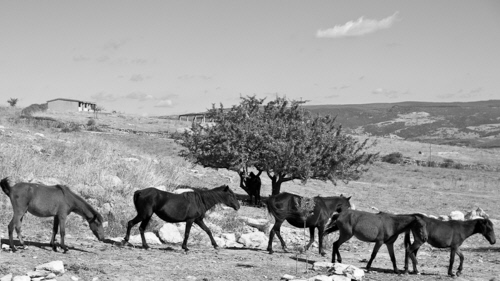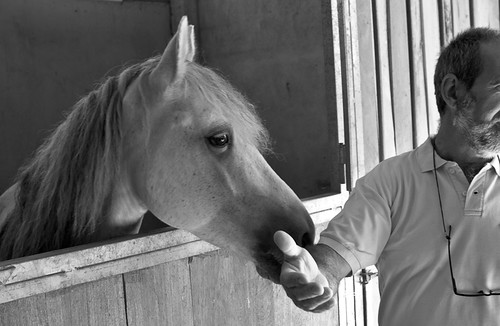We went to the Giara district located in the centre and to the south in Sardinia.
At the foot of the upland of Giara and surrounded by wide fields lies the educational farm and guesthouse “Cuaddus and Tellas “.
It is managed by Giuseppe and Franca Sedda who raise horses of Giara, Sardinian calves, pigs, goats, chickens and ducks.
Giuseppe and Franca were expecting us and since hospitality is a characteristic of many Sardinians, we were cordially welcomed and felt like home at once. While Franca was preparing coffee, Giuseppe started telling us about the horses of Giara.
Although the origin of the horses is unclear, it is assumed that the Phoenicians brought them to Sardinia about 2500 years ago, then some of them managed to escape and taking refuge in the inaccessible region of Giara where they could easily hide. Now they are considered to be aboriginal. In any case, it is natural that man used them for work since antiquity until only a short time ago. In fact, Giuseppe told us that the horses were used to separate the hay from the grain by means of trampling, but after the mechanization of agriculture in the 50s and 60s, they were replaced by threshing machines.
Not being useful any more for this type of work, the horses of Giara, being very agile and rather fast, started being bought in Sicily and used for pulling carts, but having been replaced by mechanization there too, failing to sell them to evaluators, then it was tried to increase the size of the horses by breeding them with other, bigger horses and sell their offspring to slaughterhouses.
“Fortunately”, the crossbreeds were too heavy and required too much food to be able to survive in Giara. Instead, the original horses of Giara reach a maximum weight of 150 kg (about 330 pounds), which is far too little and even inconvenient for the slaughterhouses. Thus, the horses were liberated and returned to their former homeland.
Now, the horses live in small groups and often a strong stallion live with some mares and their foals. They are very strong and rough and even their hooves are very resistant against wear and tear, a very useful characteristic in this rocky area. Due to natural selection, this race carries genes of resistance and roughness which have disappeared in domestic races. They are really genetic reservoirs and, in general, they are able to survive even when it seems like there is nothing to eat. Nowadays, about 6-700 horses live in Giara, living off the land and with no need of treatment against diseases. In fact, Giuseppe have never seen a mare bear a foal and he told us that man only intervenes when a horse is very weakened in order to decide if the horse can be saved or if it will have to be put down.
An important part of this farm is therapy with horses, a therapeutic method which has proven to be useful in aiding children with mental or physical problems. Only old and tranquil horses are used for this activity and since they are very intelligent, they recognise and adapt themselves to the ability of the children. At the same time, the children always have the same horse such that an intense relation develops between child and horse. Children with physical problems have to get used to coordinate their movements and horseriding is very useful for stimulating the leg muscles. Fortunately for the children, Giuseppe does what he can for the horses and using a modern word, he wants to maintain the biodiversity.
Unfortunately, the horses in Giara don’t have antibodies and one horse with flu can infect all the other ones, almost leading to their extermination. In order to avoid it, similar horses live at Tancaraggia and Foresta Burgos and it would be possible to use them to repopulate the horses of Giara.
Giara is a special region with very little water in summer, but quite much in winter. When it rains in winter marshes are formed, while in summer it is totally arid. In spring, the region is covered with buttercups which are eaten by the horses. Since there is so little to eat in this area, the weakest horses tend to die ensuring natural selection.
While Franca was preparing our lunch with two from our group, the rest of us went to see the animals. One horse was standing in the shade below a tree in order to avoid the flies, while a group of horses appeared at the corner of the house and moved towards small heaps of hay in front of the guesthouse. All of them were dark and according to Giuseppe, there are no light horses in Giara.
We also saw the Sardinian cows, a small, rough and aboriginal race. The cows only produce milk for their calves and this milk contains lots of fats and some other substances which don’t occur in the milk of other cows. However, the father of Giuseppe used to make pear-shaped cheeses with the milk from Sardinian cows. The market isn’t requesting the meat of the Sardinian calves and they aren’t highly valued. These animals are also being raised in order to maintain the biodiversity.
We also saw the pigs, the piglets, the goats, the chickens and even a turtle which was sleeping below a bush.
Afterwards, we returned to the guesthouse where were treated to a delicious and abundant lunch at a very low price.


